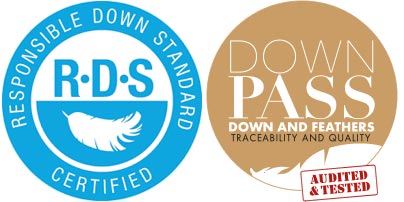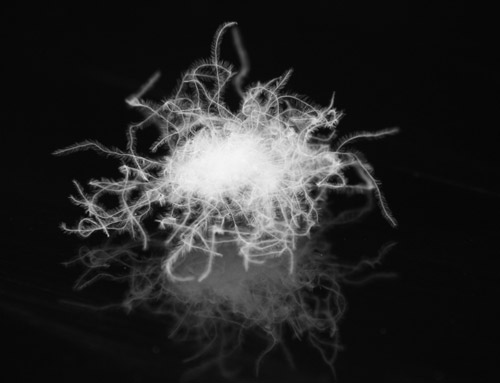Page Contents
What is Down?
Down is a pure, natural, thermal-insulation product. It is grown by birds and in cold climates it enables them to survive severe weather conditions. The best down, therefore, is to be found on birds which spend winters in arctic or sub-arctic conditions.
Down is unlike normal feathers in that it grows without a hard, central “stalk” or quill. In mature birds it forms a soft, fluffy underlayer close to the body beneath the bird’s main feathers. The most common sources of down are ducks and geese. Down is used as an insulating material in various man-made products such as sleeping bags, insulated jackets, and bed coverings.
Ethics
Down is an animal product. It is taken from ducks and geese that have been slaughtered for their meat, the down is an additional resource which can be used. If it wasn’t used it would go to waste as the birds would still be slaughtered for food. Most down is collected from ducks and although statistics vary year to year, this is roughly 90% of down collected. The reason for this is that duck is a much more popular food source than geese.
Criterion has only ever used down sourced in Poland. Poland is a member state of the EU where live plucking is illegal and has been so for a number of decades. Other parts of the world do not have as stringent animal husbandry/welfare laws as in the UK and Europe. Our supplier of down holds both the Responsible Down Standard (RDS) and the Downpass Down Standard.

Goose down is better than duck down, and POLISH GOOSE DOWN is recognised world-wide as being of THE highest quality. In particular it is beloved of the Japanese who are well known for demanding top quality and who buy large quantities of Polish down each year. The excellent quality of Polish down is partly due to climatic conditions, but is also the result of extensive academic research into breeding techniques, which are unsurpassed anywhere.
Criterion sleeping bags contain only Polish goose down, whose source is the non-polluted region of forests, lakes and beautiful, natural landscapes of North-Eastern Poland. This is a particularly cold part of Poland, suffering long winter weeks of arctic air with temperatures reaching as low as -36°C in January 2003. It is to combat such severe conditions that the geese, whose natural habitat has been this region for thousands of years, have evolved their protective down to a quality which is unmatched anywhere, both for heat retention and for durability.
Polish goose down is available in several qualities, as measured by its ability to LOFT (see below). Criterion sleeping bags incorporate the two HIGHEST qualities of Polish goose down. The higher the quality, the LESS WEIGHT of down is needed to achieve the required temperature rating for the sleeping bag. Hence high quality down means a lighter weight sleeping bag.
Criterion sleeping bags outperform competitive sleeping bags by their warmth to weight rating.
The down used by Criterion is certified by DownPass. To find out more about ethical certification read our down policy.
How Do I Know What The Quality of Down IS?
Understanding Fill Power (FP)
Down insulates by lofting and trapping warm air such as body heat. To measure loft down is subjected to a test which measures its Fill Power (FP). The Fill Power test denotes the volume (in cubic inches) to which 30 grams of down will expand when it takes in air. The greater the Fill Power, the greater the expansion and all things being equal the warmer the sleeping bag. When buying a down item you will most often see a 3 digit number followed by FP, for example 850FP. The higher the number the better the down is at insulating, essentially meaning the lighter the product.
Fill Power is the most often used guide as it is simple to understand. However understanding how warm a down product is much more than looking at Fill Power, you have to take in to consideration the quantity of down as well as the size of the product.
The Down to Feather Ratio
At slaughter down and feathers are collected together, cleaned and sifted. A 100% down product is possible but in the real world completely uneconomical. The down to feather ratio shows the amount of down and feathers within a product. Therefore knowing this ratio helps understand the quality of the down. A 95:5 ratio of down to feathers indicates much higher quality down than a 70:30 split. Due to automation the lower the percentage of feathers in the ratio will also mean that the feathers are smaller and finer, so your are much less likely to encounter quills.
The down to feather ratio is used much less than Fill Power, because generally the higher the fill power the high the down to feather ratio.
LOFT ABILITY OF PARTICULAR SLEEPING BAGS
FILL VOLUME is a measure of how much the TOTAL of all the down in a particular sleeping bag will expand. The greater the FILL VOLUME, the warmer the sleeping bag.
The ability to loft of a sleeping bag depends on the weight of down that it contains and on the fill power or quality of the down being used. A comparison between sleeping bags can be done using the equation :
(weight of down in grams) divided by 30, multiplied by the fill power
For example, compare a sleeping bag filled with 900 gms of Chinese down, with one filled with 700 gms of Polish, diamond grade goose down.
| fill power | weight of down (gms) | TOTAL FILL VOLUME | |
| Using Chinese Down | 600 | 900 | 18000 |
| Using Polish Diamond Grade Down | 850 | 700 | 19833 |
Here the lighter sleeping bag is actually warmer than the heavier one since it has a higher overall Fill Volume.
When comparing the temperature or “season” ratings quoted by different manufacturers it is worthwhile doing the above type of calculation and comparing Fill Volumes.
The so-called “minimum comfort temperature” that is quoted by most sleeping bag manufacturers is supposed to be a measure of the suitability of a particular sleeping bag for use in cold conditions. However, it is a very subjective measure (different people can tolerate different levels of cold), and furthermore, there is no “standard” to which every manufacturer adheres. Sometimes these ratings are overstated to make particular sleeping bags appear more attractive, hence such information should be treated only as a rough guide. The above FILL VOLUME equation is a measure of a sleeping bag’s ABILITY TO LOFT and is, therefore, a useful tool for cross-checking such information when comparing several different sleeping bags.
However, it should be borne in mind that good design also has an effect and, for example, a sleeping bag which utilises a Trapezoidal baffle construction will have a comfort temperature rating of 2 to 3 °C lower (better) than a sleeping bag containing exactly the same quality and weight of down, but constructed using the Boxwall method.
Other constructional design features also have an effect. The better the overall design the lower the risk of “cold spots” arising when a sleeping bag is being used.
Technical Note – temperature ratings and overall weight
1. The effectiveness of insulation materials is affected by moisture. You will feel colder in your sleeping bag in high humidity conditions. Moisture will also add to the weight of a sleeping bag.
2. How warm you feel is also dependent on where you are sleeping. The size of the body of air surrounding the sleeping bag and the amount of air movement/ventilation both affect heat retention.
The comfort temperatures that we quote for Criterion sleeping bags assume that they are being used in average humidity conditions inside typically-sized 1 to 3 person tents (with a relatively small body of still air surrounding the sleeping bag). Use them in a drafty, unheated mountain hut in damp conditions and you will feel significantly colder.
That said, independent tests, carried out on our models in compliance with British Standard BS 4745 and ISO 5085-1, gave temperature performance figures that are as good as or better than we claim.
DOWN versus SYNTHETIC INSULATION
Down is a better insulator than the best synthetic materials, “weight-for-weight”. It is lightweight with excellent loft yet is extremely compressible to give a small pack size. Down has excellent “drape” properties, settling around the body and eliminating the drafty gaps sometimes left by stiffer synthetics. However, down is a poor performer when wet, unlike some polyester fibres which resist moisture well. “Synthetics” are generally heavier and bulkier and with a much shorter life-span than down. Down’s greatest advantage, however, is its versatility as regards temperature conditions. Down sleeping bags have a wider spread of comfort temperature than synthetics, For example, a down sleeping bag with a comfort temperature rating of -15°C will still be comfortable when used at 0°C, whereas a synthetic sleeping bag rated at only -7°C could be too warm at 0°C. Anyone planning to use a sleeping bag at different times of the year in a variety of temperature conditions should consider using a down sleeping bag first and foremost.




